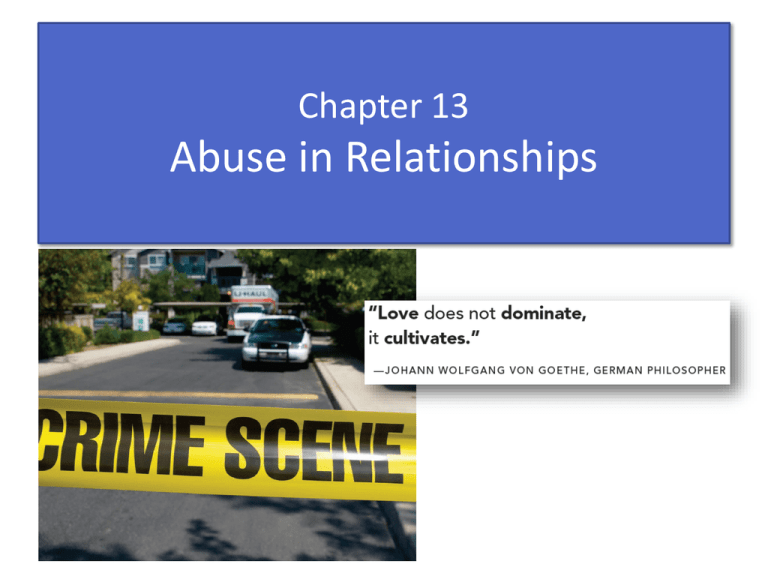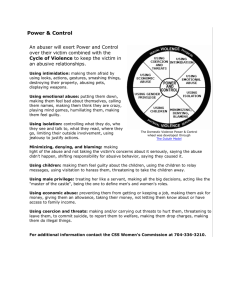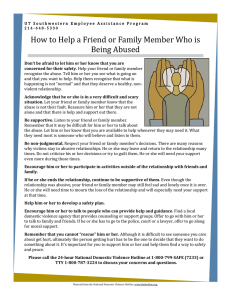
Chapter 13
Abuse in Relationships
Nature of Relationship Abuse
• Physical abuse (violence):
deliberate infliction of physical
harm by either partner on the
other
• Intimate-partner violence (IPV):
crimes committed against
current or former spouses,
boyfriends, or girlfriends
• Violence can come from either
partner as argument escalates.
Nature of Abuse
• One partner may attempt to control the other.
• Clear perpetrator and victim
• Battered-woman syndrome: general pattern
of abuse that is defined in terms of frequency,
severity, and injury
• Uxoricide: the murder of a woman by her
romantic partner
Nature of Abuse
Emotional abuse:
• Also called psychological abuse, verbal abuse,
or symbolic aggression
• Involves denigration of an individual
• Reduces the victim’s status
• Increases the victim’s vulnerability
• Involves criticism, isolation, accusation,
demanding
Nature of Abuse
• Some research shows that women and men
experience abuse with equal frequency.
• Men are less likely to report being victims.
• Women tend to be striking back rather than
controlling.
Nature of Abuse
• Stalking: unwanted following or harassment
that induces fear in a target person
• Most stalkers are heterosexual males
following a former lover.
Nature of Abuse
• Cyber-victimization: being sent unwanted email, spam, viruses, or being threatened
online
• Obsessive relational intrusion (ORI): the
relentless pursuit of intimacy with someone
who does not want it
• Intrusion includes: hyperintimacy, relentless
electronic contacts, interactional contacts,
surveillence, threat, and violence.
Explanations for Violence and Abuse in
Relationships
American culture tolerates and promotes
violence.
• Media
• Corporal punishment
• Gender inequality
– Honor crime (honor killing): killing a female who
has supposedly brought dishonor to the family
• View of women and children as property
• Stress
Explanations
Community factors that contribute to violence
and abuse in families include:
• Inaccessible or unaffordable community
services
• Social isolation
• Poverty
Explanations
Personality characteristics associated with violence
and abuse include:
• Dependency
• Jealousy
• Need to control
• Unhappiness and dissatisfaction
• Anger and aggressiveness
• Blaming others
• Alcohol and drug abuse
Explanations
Family factors associated with domestic violence
and abuse include:
• Child abuse in family of origin
• Parents who abused each other
Sexual Abuse in Undergraduate
Relationships
• Acquaintance rape: nonconsensual sex
between adults who know each other
• Date rape: nonconsensual sex between two
people who are dating or on a date
• 14 to 25% of college women experience
repeat sexual victimization during an
academic year
Abuse in Marriage Relationships
• Sexual abuse in marriage
differs from other
relationships in that the
husband may feel
“ownership.”
• Marital rape: forcible
rape by one’s spouse
Effects of Abuse
• PTSD (post traumatic stress disorder)
– Loss of interest in activities, feelings of
detachment, irritability, relationship difficulties
• Children who observed parental violence are
more likely to be depressed as adults
Cycle of Abuse
Why people stay in abusive relationships
• Entrapped: stuck and unable to extricate oneself
• Fear of loneliness
• Love
• Emotional dependency
• Hope
• Fear
• Commitment
Cycle of Abuse
• Domestic Violence Hotline (800-799-7233) is
available 24 a day
• Leaving the relationship is often very
dangerous.
• Safety plans include:
– Identifying a safe place
– Telling friends or neighbors
– Storing an escape kit
Cycle of Abuse
Prevention strategies focus on 3 levels:
• General population
– Public education
– Media campaigns
• Groups at risk
• Abusive families
– Successful therapy requires men to acknowledge
their actions and move forward.





